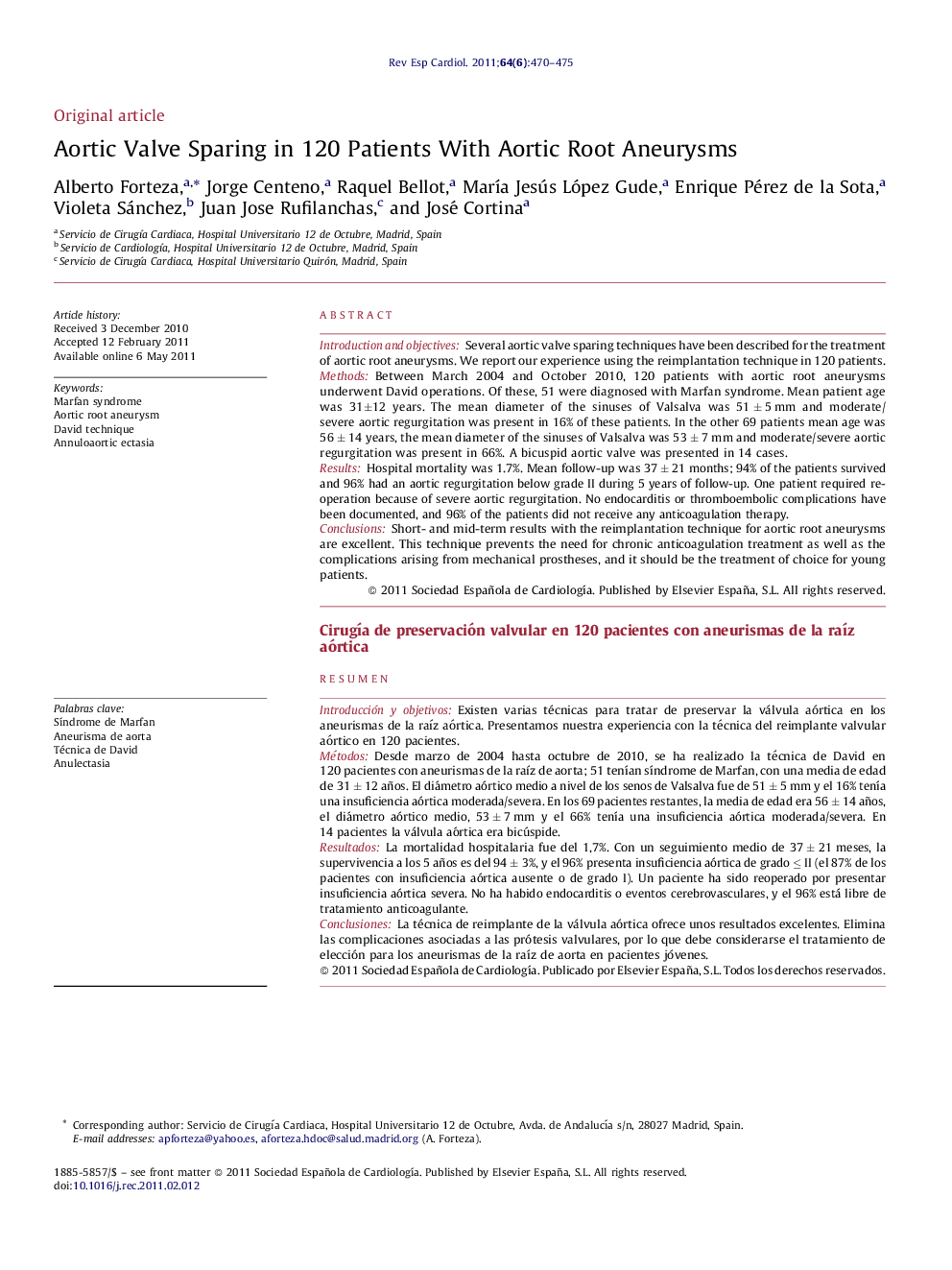| Article ID | Journal | Published Year | Pages | File Type |
|---|---|---|---|---|
| 3016878 | Revista Española de Cardiología (English Edition) | 2011 | 6 Pages |
Introduction and objectivesSeveral aortic valve sparing techniques have been described for the treatment of aortic root aneurysms. We report our experience using the reimplantation technique in 120 patients.MethodsBetween March 2004 and October 2010, 120 patients with aortic root aneurysms underwent David operations. Of these, 51 were diagnosed with Marfan syndrome. Mean patient age was 31±12 years. The mean diameter of the sinuses of Valsalva was 51 ± 5 mm and moderate/severe aortic regurgitation was present in 16% of these patients. In the other 69 patients mean age was 56 ± 14 years, the mean diameter of the sinuses of Valsalva was 53 ± 7 mm and moderate/severe aortic regurgitation was present in 66%. A bicuspid aortic valve was presented in 14 cases.ResultsHospital mortality was 1.7%. Mean follow-up was 37 ± 21 months; 94% of the patients survived and 96% had an aortic regurgitation below grade II during 5 years of follow-up. One patient required re-operation because of severe aortic regurgitation. No endocarditis or thromboembolic complications have been documented, and 96% of the patients did not receive any anticoagulation therapy.ConclusionsShort- and mid-term results with the reimplantation technique for aortic root aneurysms are excellent. This technique prevents the need for chronic anticoagulation treatment as well as the complications arising from mechanical prostheses, and it should be the treatment of choice for young patients.
ResumenIntroducción y objetivosExisten varias técnicas para tratar de preservar la válvula aórtica en los aneurismas de la raíz aórtica. Presentamos nuestra experiencia con la técnica del reimplante valvular aórtico en 120 pacientes.MétodosDesde marzo de 2004 hasta octubre de 2010, se ha realizado la técnica de David en 120 pacientes con aneurismas de la raíz de aorta; 51 tenían síndrome de Marfan, con una media de edad de 31 ± 12 años. El diámetro aórtico medio a nivel de los senos de Valsalva fue de 51 ± 5 mm y el 16% tenía una insuficiencia aórtica moderada/severa. En los 69 pacientes restantes, la media de edad era 56 ± 14 años, el diámetro aórtico medio, 53 ± 7 mm y el 66% tenía una insuficiencia aórtica moderada/severa. En 14 pacientes la válvula aórtica era bicúspide.ResultadosLa mortalidad hospitalaria fue del 1,7%. Con un seguimiento medio de 37 ± 21 meses, la supervivencia a los 5 años es del 94 ± 3%, y el 96% presenta insuficiencia aórtica de grado ≤ II (el 87% de los pacientes con insuficiencia aórtica ausente o de grado I). Un paciente ha sido reoperado por presentar insuficiencia aórtica severa. No ha habido endocarditis o eventos cerebrovasculares, y el 96% está libre de tratamiento anticoagulante.ConclusionesLa técnica de reimplante de la válvula aórtica ofrece unos resultados excelentes. Elimina las complicaciones asociadas a las prótesis valvulares, por lo que debe considerarse el tratamiento de elección para los aneurismas de la raíz de aorta en pacientes jóvenes.
